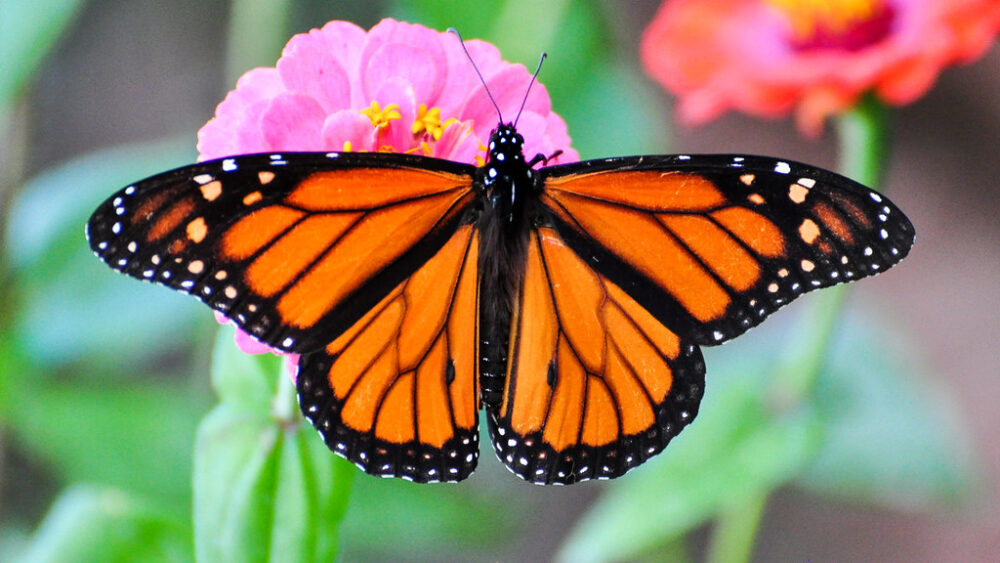The monarch butterfly exhibits perhaps the most advanced migration pattern of any insect. Their migration pattern is equivalent in complexity to that of birds, demonstrating a two-way migration. This consists of migrating from point A to point B multiple times. Point A refers to the location the butterflies reside from late March to early October. In this case, point A is North America, where monarch butterflies are split into two populations: one population east of the Rocky Mountains and the other residing west. Point B is the location where the monarchs ‘overwinter’ or reside during the colder weather to survive. For the eastern population of monarchs, point B is the Sierra Madre Mountains of Mexico, and for the western population of monarchs, is along the Pacific coast, near San Diego, California, according to researchers at the United States Department of Agriculture. Starting in early October, monarchs utilize environmental cues to begin their incredible journey toward their southern point B location, with some monarchs beginning a journey of up to 3,000 miles to reach their overwintering location.
The monarch butterfly exhibits perhaps the most advanced migration pattern of any insect
The monarchs return to the same forests of the Sierra Madre Mountains and Southern California each year, with some monarchs even overwintering on the same trees as their ancestors. Scientists and researchers aren’t sure how monarchs know exactly where to go, especially given that individual butterflies only make the journey once in their lifetime. However, in 2016, a team of researchers headed by Assistant Professor Eli Shilzerman at the University of Washington, found that using their complex eyesight and their inherent internal clock to determine the time of day, monarchs are able to follow a “sun compass” southwest. The study discovered two neural mechanisms — one inhibitory and one excitatory — that control signals from the monarchs’ internal clock genes. In simple terms, these mechanisms are able to encode the sun’s position at different times of the day based on signals from the eyes. These signals tell the monarch’s brain which direction to fly, whether it’s south in the winter or north in the spring. While the findings of this study have yet to be fully confirmed with monarch behavioral and anatomical patterns, it is the best theory scientists have as to the monarchs’ impeccable directional awareness.
using their complex eyesight and their inherent internal clock to determine the time of day, monarchs are able to follow a “sun compass” southwest.
As temperatures begin to rise near the end of March, the monarch butterflies begin their journey back to point A and begin their reproduction processes. Most male monarchs die soon after mating, while the female monarchs continue their flight north, laying eggs of the new generation in milkweed plants. The female monarchs die after laying their eggs, and the newly-born caterpillars take on the responsibility of reproducing, dying, and continuing the journey north. It takes about 3–4 generations of butterflies to completely return to the northern United States.
The monarchs return to the same forests of the Sierra Madre Mountains and Southern California each year, with some monarchs even overwintering on the same trees as their ancestors.
In July 2022, monarch butterflies were added to the World Wildlife Fund’s endangered species list. Climate change, habitat loss, and the loss of milkweed, the plant the monarchs lay their eggs in and eat, pose a serious threat to these butterflies. Monarch butterflies are essential to our ecosystem as they are primary pollinators of flowers and fruits. Without monarchs, there would be a significant impact on the food that humans consume daily as well as on the common plants and flowers that rely on the butterflies’ pollination. Conservation efforts, such as the Western Monarch Milkweed Mapper project, encourage individuals to plant milkweed and other flowers in their own backyards to provide vital resources for monarchs. Other projects report on and map the locations of milkweed plants in the United States, especially along common monarch migration paths. These conservation efforts will ensure monarch butterflies and their “sun compass” can complete the amazing journey for years to come.

